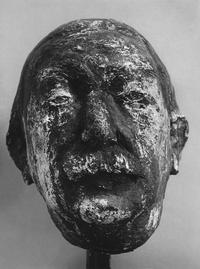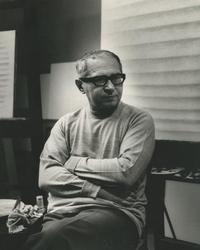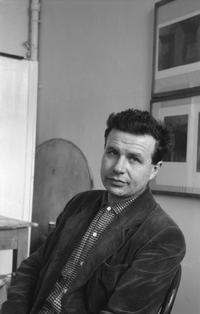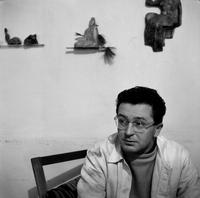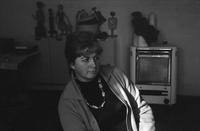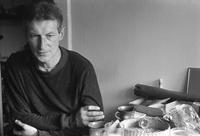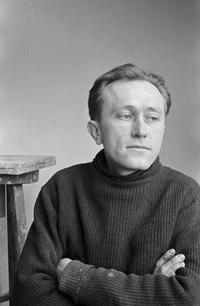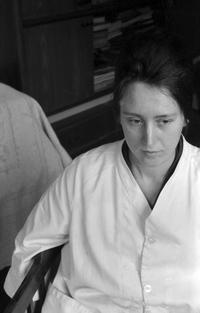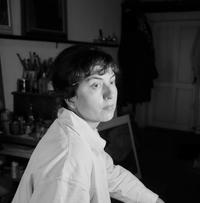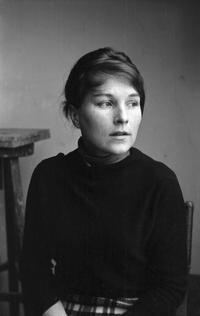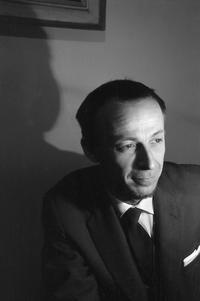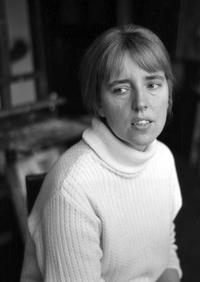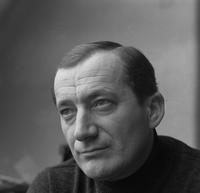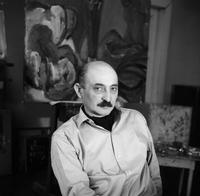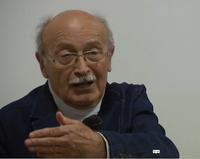The studios of the members of the group UB 12 and their portraits
The Power of Human Simplicity
The end of the fifties in Czechoslovakia. After the trial and executions of intellectuals such as Záviš Kalandra, after the currency collapse, after the state’s complete vassalage to the cruel and despotic regime to the East, distress, greyness and enmity arose everywhere. At that time, even born recluses began to gather in groups simply to have someone to talk to. Today, artists such as Adriena Šimotová, Václav Boštík and Stanislav Kolíbal are usually considered independently, but it was they who founded the group UB 12 together with other artists[1] in the early 1960s and carefully formulated a joint artistic statement. They gathered around the cultivated scholar and talented painter Václav Bartovský, who was a generation older, but who befriended them and publicly defended their creative freedom.
It was a time when the comrades refused to publish a monograph on Henry Moore or were offended by the work of Lucio Fontana, while the rest of the world was admiring his original conception of space. Stanislav Kolíbal recalls how the then head of Umělecká Beseda, Vlastimil Rada, returned from an exhibition in Paris and, with the contempt of a confirmed reactionary, told the others that Fontana’s canvases were just slashes, which disgusted the comrade all the more because they were cut all the way through. Similar outpourings pronouncements irritated the young artists until they finally left Union of the Second Regional Centre, originally Umělecká Beseda, and founded their own artistic group which would not reject the modern tradition. The link among the various personalities became Václav Bartovský’s power of human simplicity, the need for distinctive poetry and mutual friendship.[2]
One of the founding members of the group visited the studios of his colleagues in early 1962, camera in hand. It was the one who felt like an enfant terrible among them, and unlike the pacifiers [tichoslapek], who were afraid to make bullshit and remained in grey, grey-brown, or greenish tones, he was too colourful. According to him, what Vítězslav Nezval said about Kaplický applied to most members of UB 12 (students of Josef Kaplický): English clothing, French painting, Czech Josef Kaplický. Taken together, he said, they had precisely nothing in common. It was a painter of dazzling colours, light and South Bohemian themes, Oldřich Smutný.
Smutný was provocative with his statements, but his pictures are different, evoked by a feeling for the charm of the unique individual. In black-and-white photography, he preferred a wide range of white, from grey to black, which stimulated depth and imagination. He liked to take photos a lot and captured the faces of his friends from UB 12 as if “from within,” muted and lost in thought. One can see that they are related, but not the same.
Everyone has a different strategy for dealing with the regime and the conditions; they support each other and at the same time remain apart. They want to express the way they live. For all of them, art is a serious matter, and so they differ from one another significantly. In Smutný’s photographs, their studios look like houses of paintings and sculptures that come to life in daily contact with the members of the household. Only there are they seen in the true light of their inception.
For Smutný, the greatest artist of UB 12 was Jiří Mrázek, who, like Václav Boštík and Václav Bartovský, is missing from the photographs presented from 1962. The artistic group UB 12 exhibited independently for the first time in the spring of the same year. It was in the basement of the U Topičů building in Prague, originally the private gallery of František Topič, which was nationalized in 1949 and from 1950 to 1991 was administered by the Československý Spisovatel Gallery. Václav Boštík and Jiří Mrázek, however, renounced their involvement, probably out of consideration for others — they realized that their works would most likely be unacceptable to the censors. Nevertheless, the exhibition was accompanied by other complications and was closed for several days. Some works seemed to the comrades just as “abstract” or otherwise inappropriate and had to disappear. This was the case, for example, with the sculpture of Věra Janoušková and the painting “Landscape” by Jiří John, which, as Stanislav Kolíbal recalls, was too dark for the comrades, like a grave. Václav Bartovský is missing from Smutný’s photographs because he died six months before the exhibition.
In the exhibition “U Topičů,” we can view the faces of the other members of UB 12 through the eyes of Smutný, their studios and the reciprocity of their works. In the online presentation at artforgood.cz, we preserved the order and number of images on cine film and 6x6 negatives so that it is possible to look beneath the hand of the artists and glimpse the photographer’s intentions, which is all the more interesting the more thoughtfully the shutter was clicked at the time. Some images are rotated for easier viewing and all are of such quality that viewers can examine the details. The film strip is backed in black so as not to disturb its jagged edge. The photographic material was edited by Ondřej Přibyl, who intervened only to the extent that he ensured that the patina did not disappear, that is, with one exception. Oldřich Smutný laid down the condition that the publication of the pictures would not detract from the beauty of anyone’s work…
UB 12 has not existed for half a century. The resistance of their members to meaningless descriptiveness and their free thinking, of course, went against the Bolshevik regime which banned all similar groups during the time of Normalization. The individual actors, however, will of course remain figures who, despite Marxist theories and their contemporaneous supporters,[3] had a spiritual influence on the post-war generation. Václav Bartovský died shortly before the formulation of the Joint Declaration of UB 12. He became a role model for people for whom art was holy, for whom it was a religion for which one would lay down one’s life. In the photographs, one can perhaps see the “power of human simplicity,” not as a pathetic phrase, but how it is embodied in unique individuals.
Pavlína Bartoňová
[1] There were 14 founding members of 14 UB in 1961 – Bartovský, Boštík, Burant, Janoušek, Janoušková, John, Kolíbal, Mrázek, Mrázková, Prachatická, Smutný, Šetlík, Šimotová, Vitík.
[2] See the Joint Proclamation of UB 12 published on the occasion of an independent exhibition “U Topičů” in 1962. The name of the group remained unchanged since this exhibition, where 12 members exhibited.
[3] For example, the art historian Milena Bartlová even today claims that she is no interested in the moral failure of individuals or individual heroism because “in the production of knowledge of the past, they do not play any great role.” In: VODRÁŽKA Mirek. Výtvarné umění a jeho subverzní role v období normalizace. Demytologizační a detektivní příběh. Centrum pro dokumentaci totalitních režimů 2019.
Negatives once again alive and well!
When I was preparing an exhibition of Oldřich Smutný´s paintings in Telč in 2005, Oldřich said he regretted that he had photographed the studios of the members of the UB 12 artistic group in the early 1960s, but that he had already thrown away all the negatives and photos. I, too, was regretful.
Over the next few years we saw each other more often; I would help him with other exhibitions. Oldřich was an excellent companion and raconteur, and we often discussed UB 12.
Then one day Oldřich called me to say that his negatives were once again alive and well! They had been saved from destruction by his devoted disciple and friend Miro Marko. Oldřich had a network of friends, primarily from the ranks of his former scenography students, who assisted him in many practical things for the rest of his life.
When he left his studio in Nad Královskou oborou Street in Letná in 2010, he told Miro Marek to take the rest of the things or throw them away. Thanks to him, this historical and artistic document was discovered, preserved and returned to Oldřich years later.
In addition to the studio and portraits of Oldřich Smutný himself from 1962, we also see the studios and quite successful portraits of the Janoušeks, Adriena Šimotová and Jiří John, Vlasta Prachatická and Stanislav Kolíbal, Daisy Mrázková, Alena Kučerová, František Burant and the artistic theorist of the UB 12 group Jiří Šetlík. Jaromír Zemina joined the group just two years later. Václav Bartovský is also not in the photographs; he died a year before they were taken. Especially impressive are the portraits and views of the studio of Alois Vitík, who died in 1972. Unfortunately, one does not hear much about him today. Even the extensive monograph by Milena Slavická at UB 12 did not manage to include a single portrait of Vitík. On the other hand, Oldřich’s portraits wonderfully illustrate Jaromír Zemina’s book of artistic texts Via artis, Via vitae.
The strange thing is that Václav Boštík is missing from the photographs, even though Oldřich was personally very fond of him. I suppose it is because at that time he had no studio and worked at home within the circle of his large family. He left his studio to Jiří John, who had nowhere to paint.
Today, the collection of photographs by Oldřich Smutný is not only a valuable historical document, but is of undeniable artistic value. This has already been shown by several exhibitions, where many other of Oldřich’s photographs were presented.
DavidBartoň
DAVID BARTOŇ (born 1964) graduated the Czech University of Life Sciences in Brno and worked as an agricultural engineer, warehouseman, innkeeper, ceramist and director of the City Gallery in Telč. Since 1998 he has been a curator, gallery owner and artist. He paints primarily the landscape of the Bohemian-Moravian Highlands. Looks after the legacy of Oldřich Smutný and Václav Rožánek.

